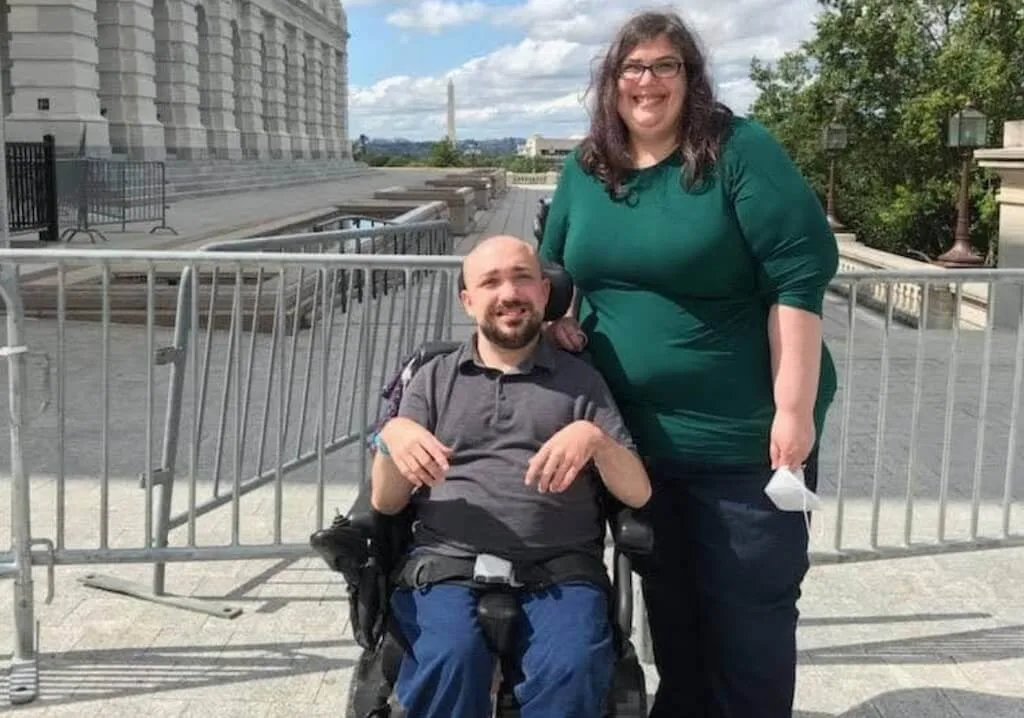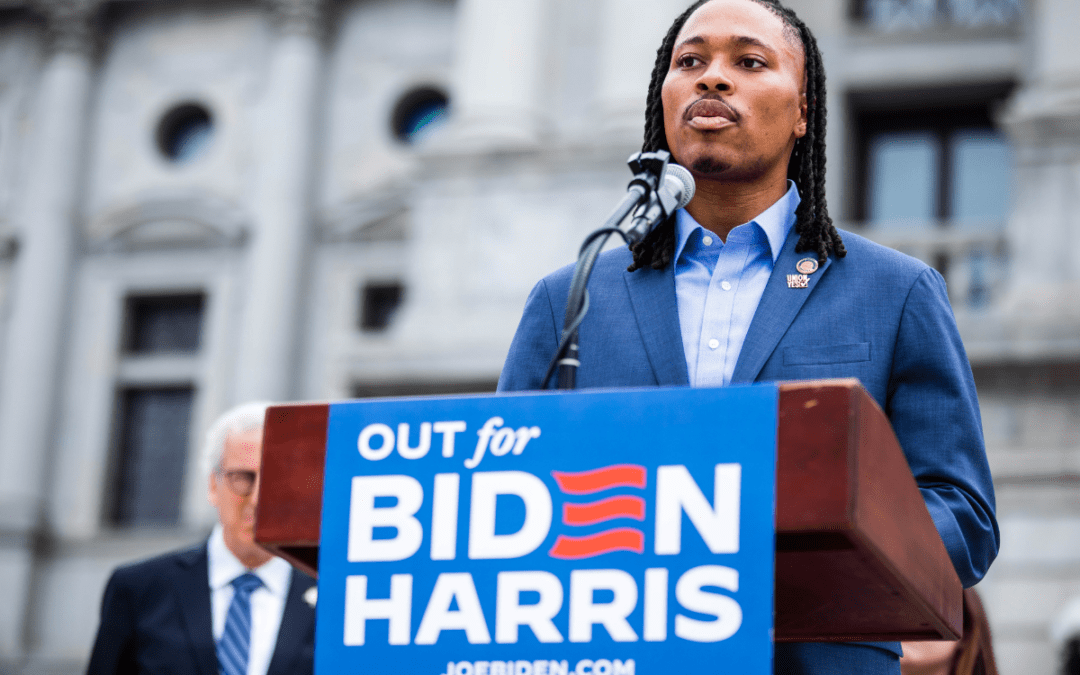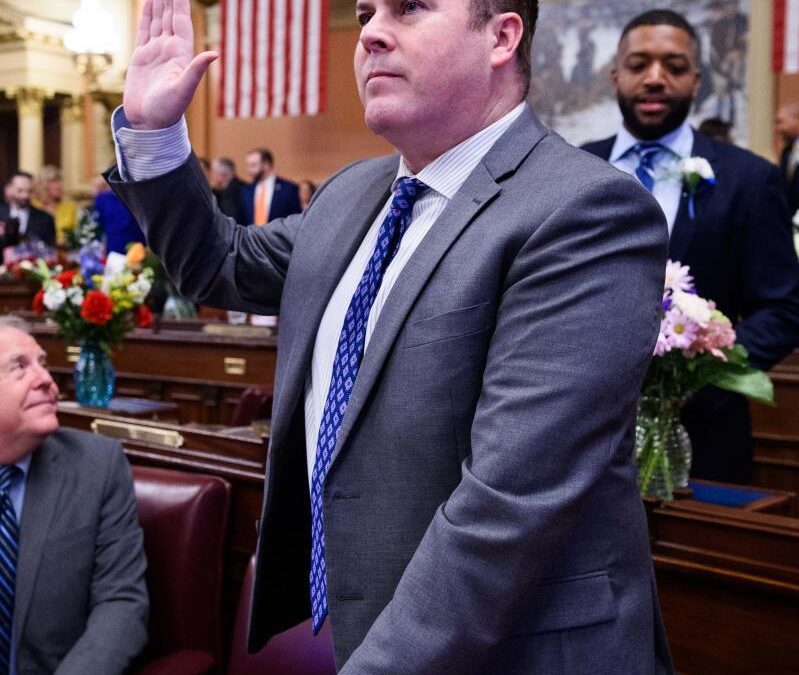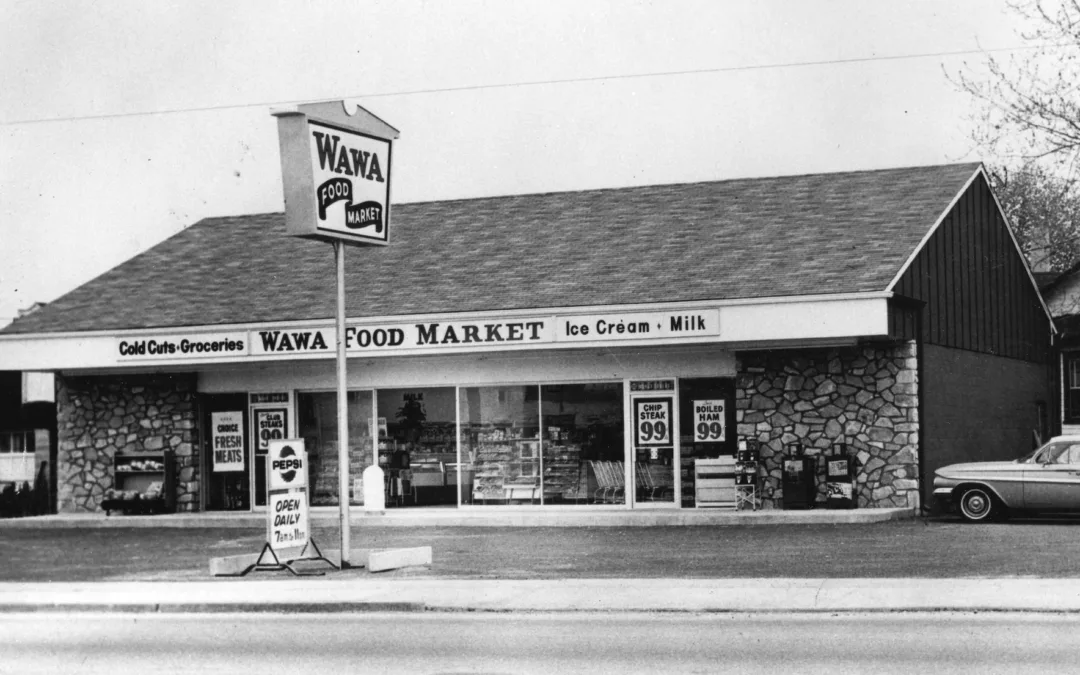
Lynn Weidner with Brandon Kingsmore in Washington, D.C. (Courtesy of Lynn Weidner).
Congress is currently debating the aspects of the Build Back Better plan, which proposes expanding Medicare, lowering prescription drug costs, and funding home-based services, all of which would have a direct impact on the lives of Pennsylvanians.
Pennsylvanians from both sides of the healthcare spectrum—patients and workers—are paying close attention to the ongoing debate over the aspects of the Build Back Better plan.
As Congress works this week to revise the social spending bill — a major part of President Joe Biden’s agenda — into a final piece of legislation that will satisfy all Democrats, some Pennsylvanians are holding out hope that some portions of the initiative are left untouched.
Hannah Zabitz wants to see the cost of prescription drugs lowered.
Brandon Kingsmore hopes the proposed increase in funding for home-based services makes the final cut.
And Lynn Weidner would like to see the paid family and medical leave proposal included in the final draft of the legislation.
Democrats spent last week slashing items from Biden’s original proposal in an effort to cut the price tag from $3.5 trillion to about $2 trillion. Promises like free community college are no longer included. Other areas, such as paid leave and expanding Medicare, are at risk.
Now more than ever, expanding access to quality, affordable health care is crucial, Rep. Susan Wild (D-Lehigh) said during a recent roundtable with healthcare advocates. She stressed that health care should be a right, not a privilege.
“No American should be forced into the choice of either buying medicine or paying the rent,” Wild said.
Prescription Drug Prices
Zabitz, a 65-year-old Bethlehem resident, has been living with a severe case of the skin disease plaque psoriasis for the last five years.
“It comes on rather quickly,” she said. “I get angry, itchy welts all around my body. The pain and itch is intense and indescribable.”
The medicine Zabitz takes to control her psoriasis outbreaks is a shot she administers twice a month. Prior to April, she had private insurance and was paying a $5 copay per shot. Once she turned 65, she had to enroll in Medicare. She now has to cover 20% of her prescription drug costs and her shots cost her between $1,400 and $1,700 each.
“I haven’t been able to get a straight answer as to what the actual price is of my prescription drug,” Zabitz said. “Insurance companies and pharmaceutical companies like to play fast and loose with people’s lives.”
Currently, Americans pay two to three times more for prescription drugs than people in other countries, a recent study showed.
Originally, the Build Back Better plan gave Medicare the power to bargain down the cost of hundreds of drugs and make those lower prices available to people with private insurance.
Now, lawmakers are negotiating a smaller, narrower program that would greatly lower the number of prescription drugs whose prices can be negotiated, with the savings only applied to Medicare and not private insurance. There is also a chance this provision will be cut from the bill entirely.
Karen Showalter, Pennsylvania Moms Force Director with Moms Rising, said she hears heartbreaking stories all the time about the costs of prescription medications.
One Pennsylvania mom needed to purchase a tube of ointment for her son’s skin rash that cost $350, Showalter said. She couldn’t afford it, so her son had to suffer unnecessary pain and discomfort, Showalter said.
Another mom Showalter talked to was paying $800 a month for insulin for her child.
“The system is really stacked against the poor in this country,” Zabitz said. “It’s inherently unfair. People are forced to make terrible choices that they never should have to make.”
Home-Based Services
While many struggle to afford healthcare and prescription drugs, healthcare workers struggle to support their own families.
Lynn Weidner is a home caregiver in Allentown. She supports a family of three on $12 an hour. She purchases her own personal protective equipment for use on the job, is not offered health insurance, and gets no paid time off.
“Home care workers cannot take care of you if we cannot take care of ourselves,” Weidener said.
She cares for Brandon Kingsmore who has cerebral palsy.
“Caregivers are everything to me because they give me the life that I need and want and have today,” Kingsmore said.
Without home-based care, the 32-year old would have to live in a nursing home.
The Build Back Better plan originally set aside $400 billion to boost home care services for older people and those with disabilities. That money would support well-paying caregiving jobs that include benefits and the ability to collectively bargain. It would greatly improve the lives of so many home healthcare workers, Weidner said.
“For me, better wages mean I could pay off crippling medical debt and afford better healthcare,” Weidner said. All while still working the job she loves.
Since Biden’s original proposal, House Democrats have approved less than half of the funding he wanted for at-home care, and that number could go even lower.
“Anybody who doesn’t believe that the caring community is part of the infrastructure has never had a family member in need of home care,” Wild said.
Politics

Malcolm Kenyatta makes history after winning primary for Pa. Auditor General
State Rep. Malcolm Kenyatta, who was first elected to the state House in 2018, won the Democratic nomination for Pa. Auditor General and will...

Biden administration bans noncompete clauses for workers
The Federal Trade Commission (FTC) voted on Tuesday to ban noncompete agreements—those pesky clauses that employers often force their workers to...

Philadelphia DA cancels arrest warrant for state Rep. Kevin Boyle on eve of Pa. primary
Philadelphia District Attorney Larry Krasner said a detective had sought the warrant against Boyle, a Democrat whose district includes a section of...
Local News

What do you know about Wawa? 7 fun facts about Pennsylvania’s beloved convenience store
Wawa has 60 years of Pennsylvania roots, and today the commonwealth’s largest private company has more than 1,000 locations along the east coast....

Conjoined twins from Berks County die at age 62
Conjoined twins Lori and George Schappell, who pursued separate careers, interests and relationships during lives that defied medical expectations,...






